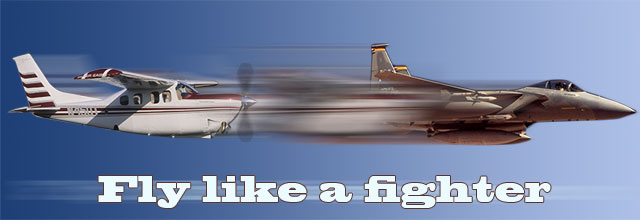
Last month I wrote about an actual missile shot that I took. In this article, I will tell you about shooting the gun, which we actually got to do quite regularly because we had to maintain currency with this as part of our training plan.
 The F-15 gunsight displayed on the heads up display (HUD) as a round circle about an inch in diameter with a small pipper in the center. With a radar lock, the range to target would display as a solid arc along the circumference of the circle matching clock positions. At a 3,000-foot range, the arc would extend from the 12 o’clock position to the 3 o’clock position. The computer ran lots of calculations to move the pipper to the forecast bullet position based on your own and the target’s flight parameters. This meant that a steady hand was necessary to keep the pipper in one spot on the target.
The F-15 gunsight displayed on the heads up display (HUD) as a round circle about an inch in diameter with a small pipper in the center. With a radar lock, the range to target would display as a solid arc along the circumference of the circle matching clock positions. At a 3,000-foot range, the arc would extend from the 12 o’clock position to the 3 o’clock position. The computer ran lots of calculations to move the pipper to the forecast bullet position based on your own and the target’s flight parameters. This meant that a steady hand was necessary to keep the pipper in one spot on the target.
We shot actual bullets at a plywood dart towed on a 1,500 foot cable behind a manned F-86 Sabre Jet. The F-86 took off with the dart mounted under its wing, then strung it out on the cable once in the training area. The dart was covered with metallic foil so that we could get a radar lock on it. We practiced many different types of intercepts on the F-86, but ultimately all of our gunshots were taken near a stern position with the F-86 performing a 3-to 4-G spiraling turn. We always had to shoot from inside the turn so that bullets stayed away from the F-86.
The dart was small, only about 20 feet long and 5 feet wide. (In comparison, an F-16 is 49 feet long, and an F-15 is 64 feet long). This made it a challenge to hit. But it also meant that if you could hit the dart you could hit whatever fighter you were aiming at in combat. I am embarrassed to say that I missed the dart on my first attempt while training as an F-15 student. When I reviewed my video with my instructor it was obvious why. I was quickly trying to move the pipper onto the target by moving the stick up, down, up, down to get into position. I was only moving the stick about an inch total, but every time I did this the flight computer had to recalculate my parameters and so my gunsight kept moving ever so slightly with each stick movement. To put things into perspective, at a range of 1,500 feet, a pitch change of one-half a degree will cause a bullet to move 13 feet–enough to miss the target.
My instructor told me to set the Gs and get the pipper close, then relax and slowly move the pipper forward or backward with only slightly more or less pull on the stick to get a stable shot. I never missed the dart after that.
Even in our general aviation airplanes, precision flying down to one-half of a degree of pitch or less is required for some maneuvers. Maintaining level flight, flying a visual or instrument final approach, and the roundout and flare are just a few that come to mind. If you find yourself rushing and over controlling the airplane, first make sure that your trim is set. Then do what my instructor taught me: Relax, and then slightly adjust your pitch to put the airplane exactly where you want it.
Larry Brown of Colorado Springs, Colo., is a retired Air Force F-15 pilot who is using the lessons he learned as a fighter pilot as a GA pilot in his Cessna P210. Brown, who has 2,700 hours total time during his 33 years of flying, also was an instructor pilot and flight examiner in the Air Force T-38 and instructor pilot in the T-52, the military’s version of GA’s Diamond DA40. See previous installments of “Fly like a fighter.”



